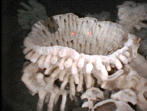Sponge Reefs
Background information

Sponges are animals that filter water through their porous body surface to extract food particles and dissolved substances. They are not mobile but stay their whole adult lives in one place much like a plant. There are more than 7,000 described species of sponges alive today in both fresh and marine waters and many more that remain to be described and named by scientists. Different groups of sponges make their spicules that form the sponge's skeleton out of different materials. These materials may include silica, carbonate and protein fibres. Sponges have been traditionally harvested in various places in the world as the well known "bath sponge" and increasingly are becoming important sources of bioactive agents for the pharmaceutical industry.
Sponges are among the oldest known multicellular animals, sponge spicules have been found in Precambrian rock layers more than 600 million years old. From this perspective they are a very successful group having lived on earth through many crises and extinctions. The sponges that make spicules from silica include the Hexactinellids and Lithistids. In offshore British Columbia, as in many places on our watery planet, Hexactinellid sponges have been quite successful at making a living and are quite common.
Continental Shelf environment

The sponge reefs have grown in the deeper part of the continental shelf - the edge of the North American continent that is covered by seawater. The seabed of the continental shelf is a fascinating environment. Much of the "shelf" was covered by ice hundreds of metres thick between 20,000-14000 years ago. During this time sealevel was very different than today and when the ice retreated much of the shelf was dry land between 14000 and 10000 - before being flooded by water returning to the sea from melting glaciers. All these dramatic environmental changes have left a lasting impression on the surface of the continental shelf. The glaciers left thick sediment deposits and the sea level changes left an incredible variety of landforms like spits and beaches usually found at the shoreline now many kilometres offshore beneath 100 to 200 metres of water. Little new sediment is deposited on our shelf because most of the sediment is trapped in the deep fiords and channels at the edge of the coastal mountains. The surface and seabed currents are quite strong and the shelf waters are rich in nutrients and these factors make the region biologically productive.
The foundation for building the reef
When ice covered the continental shelf it left deposits behind which contained a mix of sand, gravel and mud. In many areas large icebergs were broken off as the glaciers receded. These large icebergs scoured and ploughed up the seabed, making long deep scratches or furrows in the seafloor. The ploughing of the icebergs caused large boulders to be pushed up to the seabed and concentrated along the edge of the furrow. The furrows are in such deep water that they have remained unchanged for thousands of years. The large boulders in deep water are a stable site for attachment and growth of sponges or other filter feeding organisms. These are the initial sites of growth of the sponge reefs where a hard substrate is available in a very stable area of low sedimentation and relatively fast - (about 1.6 kilometres per hour) currents. These currents ensure an adequate supply of nutrients is delivered to the reef sites and that suspended sediment remains in suspension and does not blanket the reef surface.
